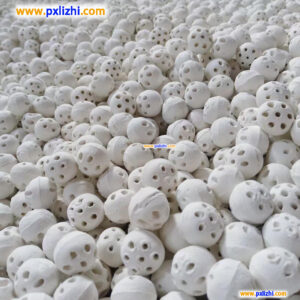
**Understanding Inert Ceramic Balls**
Inert ceramic balls are specialized spherical fillers made from high-purity, chemically inert materials like alumina or zirconia. They are engineered to withstand extreme temperatures, pressure, and corrosive environments without reacting with process materials. These balls serve as essential components in industrial applications, primarily as tower packing to support catalysts, distribute liquids and gases evenly, and prevent the clogging of beds in reactors. Their high mechanical strength and thermal stability make them indispensable in demanding processes.
**Key Properties of Inert Ceramic Balls**
The effectiveness of inert ceramic balls stems from their unique physical and chemical characteristics. They exhibit exceptional resistance to thermal shock, allowing them to endure rapid temperature changes without cracking. Their high crushing strength ensures structural integrity under heavy loads, while their chemical inertness guarantees no contamination of processed materials. Additionally, these balls have low water absorption and excellent abrasion resistance, contributing to a long operational lifespan even in harsh conditions.
**Thermal and Chemical Stability**
One of the most valued properties is their ability to maintain performance in aggressive chemical environments and at temperatures exceeding 1000°C. This makes them ideal for use in petrochemical, refining, and chemical synthesis processes where reactive intermediates are present.
**Wide-Ranging Applications**
Inert ceramic balls are versatile and used across multiple industries. In the oil and gas sector, they are employed in catalytic reformers and hydrotreaters to protect catalyst beds. The chemical industry utilizes them in reactors and distillation columns to improve flow distribution. They also play a role in environmental applications, such as in scrubbers and air pollution control systems, and are even used as grinding media in ball mills due to their hardness and wear resistance.
**Role in Industrial Processes**
By providing a stable, inert surface, these balls help maximize catalyst efficiency, reduce pressure drops, and enhance heat transfer within industrial units. Their use leads to more consistent product quality and reduced operational downtime.
**Top Benefits for Your Operations**
Integrating inert ceramic ball solutions into your systems offers significant advantages. They extend the life of valuable catalysts by preventing dust and fines from fouling the bed, leading to substantial cost savings. Their durability reduces the frequency of replacements and maintenance, while their efficiency in distributing fluids can enhance overall process yield and energy efficiency. Ultimately, they contribute to safer, more reliable, and more economical industrial operations.
**Frequently Asked Questions**
What materials are inert ceramic balls made from?
They are typically manufactured from high-alumina content ceramics, zirconia, or other refractory compounds chosen for their inertness and strength.
How do I select the right size and material?
Selection depends on your specific application, operating temperature, chemical environment, and the size of the catalyst or packing they support. Consulting with a specialist is recommended.
Can they be reused or regenerated?
Yes, due to their high durability and inert nature, they can often be cleaned and reused multiple times, provided they haven’t suffered physical damage.
**Optimize Your Process Today**
Ready to enhance the efficiency and longevity of your industrial systems? Explore our high-performance inert ceramic ball products to find the perfect solution for your needs. Contact our experts now for a personalized consultation and see the difference in your operations!
